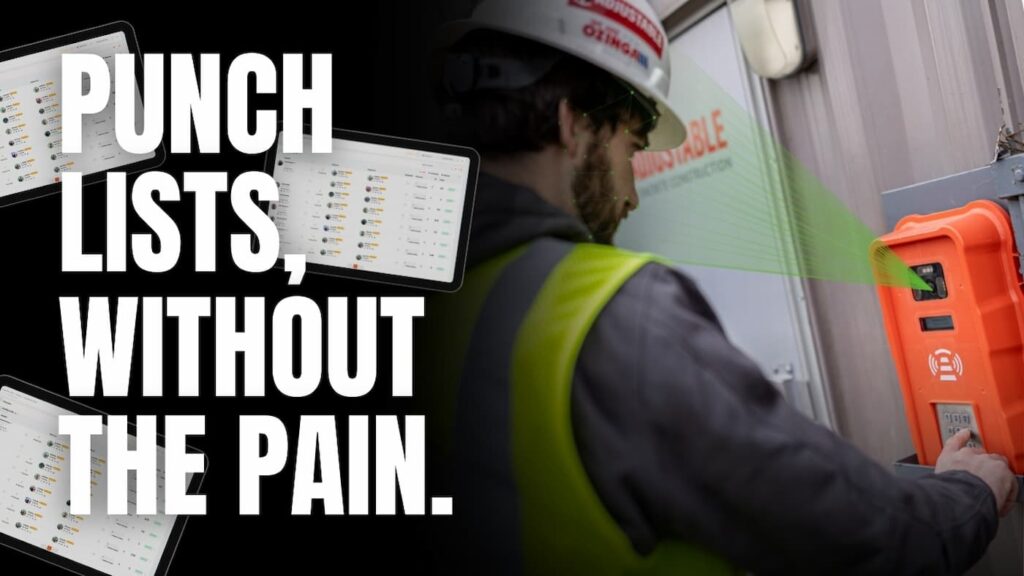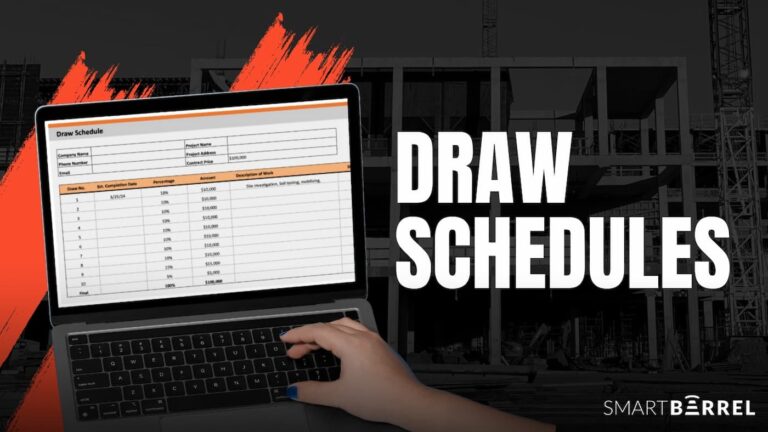Table of Contents
Punch lists are supposed to wrap a project up, not drag it out. Too often they end up stacked with notes about unfinished electrical, unprotected finishes, or missing materials.
The issue isn’t effort. It’s when quality checks are left too late instead of being built in from day one.
For subs, a bloated punch list means callbacks, rework, and crews pulled off other jobs. It’s not just an extra hassle; it can eat into profit and delay payment.
A punch list is meant to confirm that work meets standards and flag what’s left, but when communication breaks down or updates don’t flow from the field, subs are the ones left scrambling to fix it.
5 Reasons Construction Punch Lists Get Bloated and Backlogged
No Daily Oversight in the Field
The biggest cause of bloated punch lists is waiting until the end of the project to address issues. Without daily fixes, you’re left with a list long enough to stretch across the jobsite. Crews end up redoing work they already finished, wasting hours and killing momentum.
Poor Communication and Coordination
When the GC, owner, and subs don’t align early on what “done” really means, punch lists explode. Without clear updates from the field, subs get stuck chasing clarification instead of focusing on the next project.
Incomplete or Inaccurate Punch Lists
Rushed or vague punch lists almost always lead to mini lists that drag out closeout. Missing details force crews to guess at fixes or redo work multiple times. Clear descriptions up front mean fewer callbacks and less wasted time.
Procrastination
When punch items sit untouched, urgency fades. Crews may already be reassigned to the next job, leaving unfinished work behind. That pushes deadlines back, cuts into profit, and delays retainage. If retainage is your only motivator, you’re already losing money.
As mentioned in How to Write a Contractor Payment Schedule, a retainage of 5-10% of the total contract value is withheld until project completion. If that’s your only motivator, you’re already losing money.
Lack of Proper Tools and Systems
Paper lists and spreadsheets slow everything down and invite mistakes. Field-ready tools that log photos, verified hours, and cost codes in real time keep closeout moving and reduce rework.
Get Control of Your Time Tracking
Get Control of Your Time Tracking
How a Zero Punch List Pays Off
A “zero punch list” in construction refers to the ultimate goal of completing a project with zero items on the punch list at the time of the final walkthrough. The client walks through a flawlessly completed jobsite and finds no issues or areas needing improvement.
While zero punch lists are rare in practice, they’re still a smart goal. Contractors who work toward zero, even if they don’t fully hit it, end up saving time, reducing rework, and closing out jobs faster. It’s not about perfection. It’s about having fewer surprises, fewer callbacks, and a smoother handoff when it counts.
Saving Time
The most direct way to save time is to avoid needing a crew to return to the jobsite. Every return trip to fix something costs hours you didn’t plan for and pulls crews off other work. Rework also burns energy; it takes more effort to redo a task than to get it right the first time. When punch list items get caught early, crews can finish and move on without losing momentum.
Saving Money
Rework is expensive, sometimes costing contractors 15% of the total project cost. Focusing on quality from day one reduces the chances of callbacks, warranty claims, or missed deadlines that hold up payment. Reducing rework helps clear the way for faster approvals and steadier cash flow. Administrative office work also significantly decreases and reduces overhead costs for the contract.
Reputation Enhancement
When clients walk into a nearly finished project and find only minor items left to resolve, it builds trust and shows that the team stayed on top of quality throughout the job.
Strong relationships with clients and the community help you stand out from your competitors and gain an advantage. Referred customers increase company profits 16% on average.
Day 1: Building Towards a Zero Punch List
A zero punch list isn’t something you tackle at the end of a project. It’s a foundational commitment that should influence and guide every step of your work.
Pre Construction
- Confirm all contract documents, schedules, resources, and job specifications are understood and agreed upon.
- Before any tools are unpacked, clearly define what “acceptable quality” is for each group of tasks.
- Create benchmark examples, approved by the owner, for workers to check their work against.
- Finally, have a kick-off meeting with all parties for one last review of goals, scope of work, and the schedule.
During Construction
- Implement a rolling punch list as a quality assurance measure to quickly identify inefficiencies.
- Make daily walk-throughs a regular habit to safeguard against inefficiencies.
- If a project task involves more than one trade, require an inspection when one trade finishes before the next trade begins.
- Tools like SmartBarrel give contractors verified time data that supports daily logs and job costing, making it easier to stay ahead of closeout tasks.
- Establish guidelines for protecting finished work, like tarps or coverings.
Continuous Improvement
- Properly train all workers on quality standards and installation methods.
- When mistakes happen, analyze why they happened to reduce the chances of them happening again.
- Reward quality work or discuss poor workmanship to increase accountability and boost worker morale.
Pre-Punch List Walkthroughs
- A “pre-punch” walkthrough before the owner or client performs their walkthrough allows extra time to fix any problems that have minor effects, as well as any minor issues like scuffs or marks.
Tactics That Work
Being Detailed and Specific
Always take clear photos or short videos of all issues to make it easier to reference.
Be as specific as possible when documenting issues or areas of rework.
If the wiring is defective, indicate which wire, which room, and how that defect is causing a problem. Be sure to include the solution or what needs to be done.
Assigning Ownership and Expectations
Assign each item to the responsible worker or contractor.
Set clear and realistic deadlines while consistently following up.
Prioritizing Issues
- Immediately address safety hazards.
- Prioritize time-sensitive tasks.
- When something breaks, clean it up immediately.
- Don’t wait until the end of the day to resolve issues when they become a bigger problem.
Optimizing Technology
Verified time punches with photos and GPS create reliable records of who was on site and when.
Geofenced logging ensures hours are tied to the correct jobsite.
Cost code tracking links labor activity directly to project tasks for accurate job costing.
Automated daily logs reduce manual entry and keep the office synced with the field.
SMS communication tools give crews real-time updates, all automatically documented.
Scheduling Rework Efficiently
- Group tasks together for contractors once items are assigned.
- Coordinate a punch list that doesn’t disrupt other work going on.
Rolling Punch List Strategies
A rolling punch list is a fundamental shift in strategy. Instead of a single, massive list at the end, it involves continuous identification and resolution of issues throughout the project.
Empower the Field Team with Quality Ownership
Empower project managers to perform daily quality checks and immediately document and assign deficiencies. Foster a culture where any team member who spots an issue documents it, regardless of whose responsibility it is.
Utilize Technology for Real-Time Tracking
As mentioned in the tactics, punch list software is crucial for a rolling punch list. It allows for immediate documentation, assignment, and tracking, ensuring items don’t get lost and providing real-time visibility into progress.
Proactive Protection of Finished Work
Implement detailed plans for protecting finished surfaces, installations, and materials from damage by subsequent trades or ongoing activities. This includes temporary coverings, barriers, and strict site rules.
By implementing these strategies, contractors can significantly reduce the number of items that appear on the final punch list, leading to smoother project closeouts, happier clients, and a stronger reputation.
Tools That Pick Up the Pace
To prevent slowing down, especially in the context of construction punch lists, you need tools that enhance efficiency, communication, and proactive problem-solving.
Automated Time Tracking Reporting
Choose tools that connect time tracking and daily logs seamlessly. SmartBarrel feeds verified hours, photos, and cost-coded data directly into construction platforms like Procore, giving teams the field documentation they need without chasing it down. Contractors need a time tracking solution that cuts down admin time and supports closeout without manual cleanup. Look for tools that can:
- Centralize labor data, field notes, and photos into your daily logs.
- Use cost-coded labor data to understand time spent during punch list resolution.
- Photos tied to time records can support daily log documentation.
- Assign responsibility, track progress, and run reports in real-time.
Companies that tackle this with SmartBarrel and construction management software like Procore save time on manual data entry and improve the quality of their data.
“SmartBarrel feeding data directly into Procore saves time on manual entry and also improves the quality of the data.“ Lawrence Auon – President | Gilbane Construction
Communication & Real-time Collaboration Tools
SmartBarrel’s broadcast messaging feature lets you send real-time updates straight to the crew, no group chats, no guessing. Send jobsite updates, alerts, and safety notices to the whole crew, instantly, right on their phones.
Shared Document Platforms
Ensure everyone has access to the latest versions of documents, schedule changes, and change orders. Real-time collaboration on documents prevents delays from outdated information or software versions.
Scheduling & Planning
Use SmartBarrel’s verified data to support scheduling and keep crews accountable. With verifiable data, you can make sure complex project details and limited resources won’t get missed or wasted.
Quality Control & Inspections
Drones quickly inspect large or inaccessible areas to identify issues that contractors might normally miss, like roofs or elevated structures, making it easier to spot issues early, before they snowball into rework.
Digital checklists standardize the inspection process by requiring task details and photos to be in one place, ensuring that quality checks are performed throughout the project. This helps prevent items that later appear again on the punch list.
Integration and Adoption
The best tools won’t fix punch list problems if they’re rolled out the wrong way. Poor implementation is one of the biggest reasons jobsite tools fail, not the tool itself.
Remember these key things when selecting tools:
- Ease of Use
- Mobile Accessibility
- Integration Capabilities
- Scalability
- Support & Training
When implementing these tools effectively, you’re on the right path to achieving a zero punch list.
How Verified Time Tracking Helps You Close Out Faster
Verified time tracking is a powerful tool for accelerating punch list closeout for several key reasons, by enhancing accountability, transparency, efficiency, and accurate cost control.
Increased Accountability for Subcontractors and Crews
With verified time tracking, you can confirm which crews were on site, when they worked, and for how long, giving you the documentation to back up punch list progress. This eliminates inflated hours and “buddy-punching”.
When a subcontractor claims they worked on an item, time tracking provides verifiable data. If they haven’t logged time, you’ll catch it before payroll goes out, and you can hold the right crews accountable.
Verified time tracking shows when crews were on site and for how long. It helps confirm if work tied to a punch list deadline happened within the expected window, without relying on guesswork or memory.
Improved Efficiency and Resource Allocation
Identify Trends
- By tracking the time tied to cost codes or specific tasks, you can identify and address where productivity is the lowest.
Crew Optimization
- Accurate estimates of the number of hours needed to complete the task or punch list
- Allocate resources effectively to prevent over-staffing or under-staffing for punch list work.
- Geofencing confirms workers were on-site at the time of punch.
Faster Dispute Resolution and Fewer Chargebacks
Data-Backed Resolution
- When a dispute arises, verified time tracking provides objective data. You can show who was on-site, when, and for how long.
Chargebacks
- If you need to charge back a subcontractor for poor workmanship, verified time data supports labor-based chargebacks when crews were absent or left work incomplete.
Accurate Cost Control and Billing
Precise Job Costing
- Verified time tracking gives you accurate hours by cost code to support labor cost tracking.
Informed Future Bidding
- Past data on how long certain tasks or codes took provides valuable insights for future bids, allowing you to allocate proper resources and position yourself better to reduce last-minute punch work.
By providing verifiable data on who, what, and when, SmartBarrel helps resolve labor-related issues faster.
“SmartBarrel was an obvious choice; a simple solution that provides very high quality, useful data.” Luke Harmon – Executive VP | Prism Electric
Get Control of Your Time Tracking
Final Walkthrough Tips That Save You Weeks
The final walkthrough is often the last hurdle before project closeout and payment.
BEFORE
Final Walkthrough = Walk in the Park
If you’ve been doing “rolling punch lists” and frequent quality checks throughout the project, the final walkthrough should only be confirming that the last few items are truly complete. If the final walkthrough is the first thorough review of your work, it will be a long and painful walk.
Pre-Punch Walk
Before the owner/architect walkthrough, a “pre-punch” walkthrough should be conducted. Identify every issue and fix as many as possible. The goal is to present a project that is as close to perfect as possible to the client.
Set Expectations
Reiterate that this walkthrough is for identifying deficiencies against the contract documents, not for new scope requests or design changes. Have a clear process for handling potential change orders that arise.
Confirm Time and Participants
Confirm who will be attending from all parties: the owner, architect, GCs, PMs, and subcontractors. Set a realistic time estimate for the walk based on project size and complexity, but don’t rush if legitimate issues are beginning to accumulate.
Decide beforehand how items will be documented. This prevents delays during the walk itself.
Cleanliness
- Ensure the entire site is clean, dust-free, and organized. A messy site can make it harder to spot actual defects. Check that all areas are easily accessible.
- The walkthrough lead from the GC’s team should be familiar with the project, equipped with a copy of the contract, and willing and able to answer questions on the spot.
DURING
Recording
Designate one person to document all punch list items to prevent duplication and ensure consistency.
Clarification and Documentation
Take a clear photo, provide a concise description, and pinpoint the exact location after each item is identified.
Be Professional and Efficient
- While you can seek clarification, avoid getting into lengthy arguments about whether something is a defect or not during the walkthrough. Document it, move on, and mark it for a separate discussion after the walk.
- Follow an efficient and logical path through the jobsite. Don’t jump around, as this leads to missed items and wasted time.
AFTER
Distribute Immediately
As soon as possible after the walkthrough, distribute the full punch list to all relevant parties.
Schedule Remediation
Immediately schedule the trades to address their items. Prioritize based on severity and impact on subsequent work or final sign-off.
Verify Completion Promptly
As each trade marks their items complete, have a GC or representative verify them. Utilize photos from the field (benchmark examples) to speed up internal checks.
Use verified time data to confirm crews were on site and working during remediation, backing up progress logs if timelines are questioned.
Final Sign-Off
Once all items are verified and complete by the GC, conduct a final walkthrough with the owner for sign-off and release of retainage.
Wrap-Up
The secret’s out. Exhausting punch lists don’t happen overnight. They build up day by day, one missed inspection after another.
Contractors who strive for zero punch lists on day 1 find themselves saving time and money project after project.
Want to close jobs faster, with less rework and fewer delays? Book a SmartBarrel demo to see how it works.




